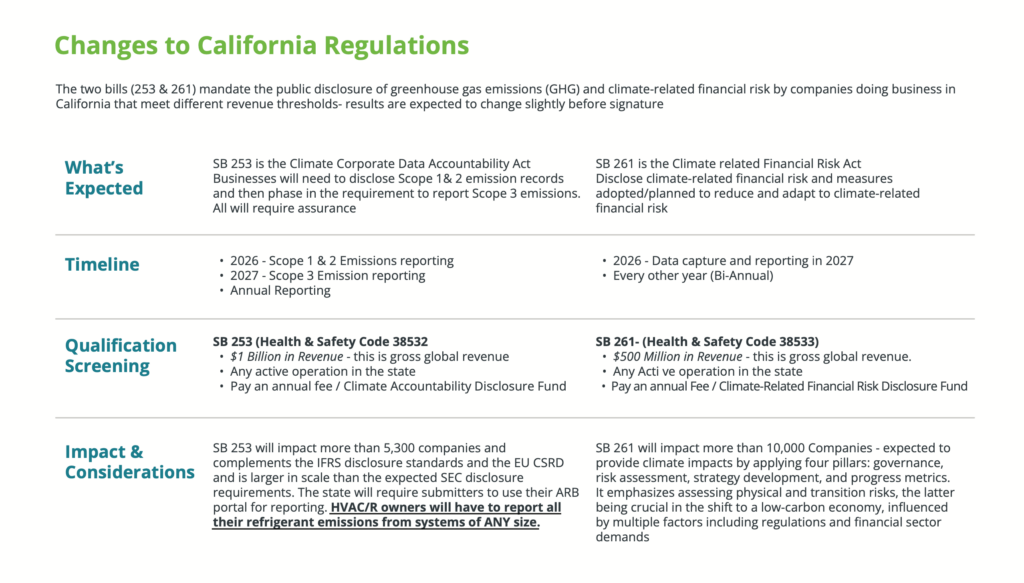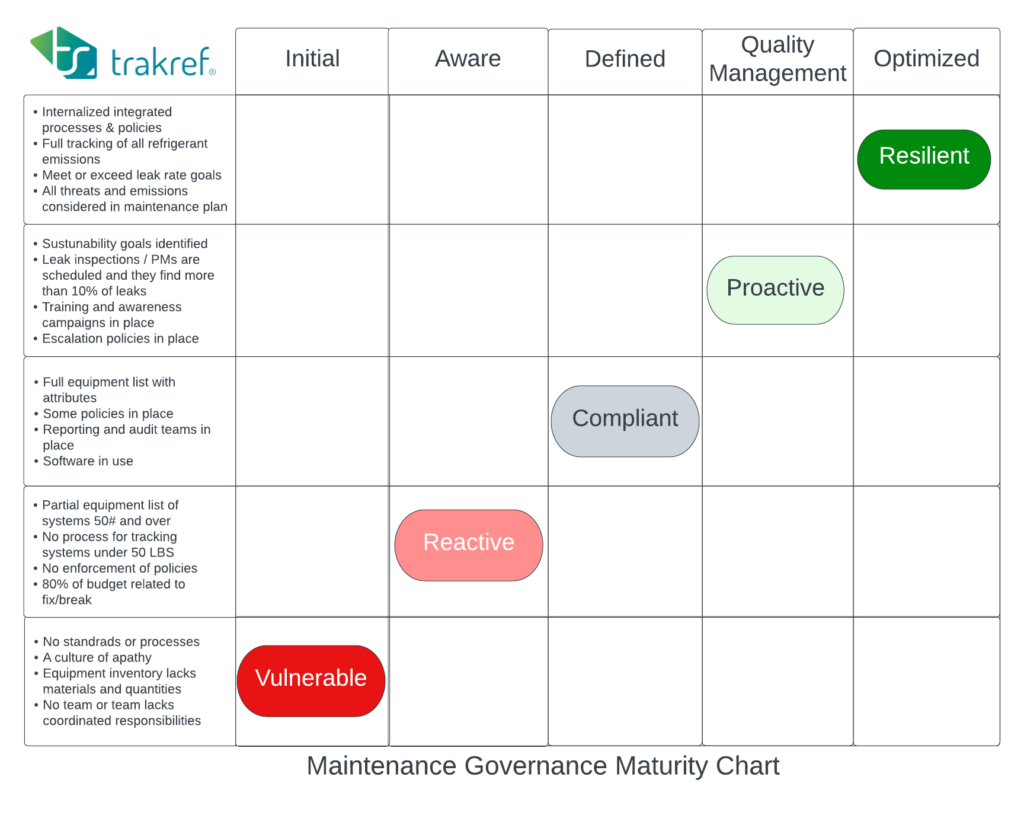
Trakref
California SB 253 & SB 261: New Climate Disclosure Laws Guide 2024

SB 253 & SB 261 will establish the First Climate-Related Accountability and Financial Risk Disclosure requirement in the United States. The two bills, SB 253 & SB 261 will have a ripple effect on buildings and HVAC/R owners and operators everywhere – even those operating outside of the state of California.
California recognizes that it is important to provide a consistent and transparent way for organizations to communicate to investors, lenders, insurers, and other stakeholders about how climate change impacts their businesses institutional investments, and the lives and lifestyles of the people they effect. Additionally, Corporations play a critical role in any effort to make deep cuts to greenhouse gas emissions. Studies have found that as much as more than 70% of all historic greenhouse gas emissions are attributable to businesses and companies. Without corporate action to reduce these emissions, California would be unable to meet its climate goals.
The two bills together are often referred to as the Climate Accountability Package and they are intended to re-establish California’s leadership on these issues with two complementary measures, SB 253 and SB 261, to increase transparency around corporations’ emissions and investments. Due to the lack of transparency around their climate risks and impact, large corporations currently evade the scope of many state regulations and can mislead potential customers who wish to minimize their contributions to the climate crisis.
SB253 Introduced by (Senator Weiner) The Climate Corporate Data Accountability Act, began life in 2022, which failed by one vote last year however the Senate was energized this year and viewed this climate action, as “unfinished business” and succeeded by one vote in September 2023. It is now on the Governor’s desk.,
SB 261 introduced by (Senator Stern) focuses on financial risk related to the climate crisis and is intended to protect consumers that stand to lose billions of dollars collectively if financial institutions fail to account for new risks associated with climate change.
Gov. Gavin Newsom on Sunday (September 18, 2023) announced that he will sign the bills:
“Asked at the start of “Climate Week” in New York (September 18, 2023), a week of events coinciding with the U.N. General Assembly, whether he would sign the bill, Newsom replied: “Of course I will sign that bill “
There is a third bill that is part of the suite of bills submitted during this session of the legislature, it is known as SB 252 and applies only to two California state pension funds, so for the purposes of this article, we will focus on the Climate Corporate Data Accountability Act (SB 253) and the Climate-Related Financial Risk Act (SB 261).
California is anticipating that the enactment of the suite of regulations, will be a catalyst for investment in technology to address any challenges. By leveraging its technology leadership position and strong associated employment base the state expects to innovate its way to the solution, fight against climate change, establish a new standard in environmental conservation and drive opportunity and prosperity for businesses.
Overview of the Bills
SB 253: Climate Corporate Data Accountability Act, requires all large corporations that do business in California to publicly disclose their direct greenhouse gas emissions (emissions) in line with the Greenhouse Gas Protocol (GHG Protocol) , the longstanding gold accounting standard established by the environmental and business communities. This includes Scope 1, Scope 2 & Scope 3 of emissions reporting.
Greenhouse Gasses: Climate-related Financial Risk (SB 261) – SB 261 (Senator Stern) is modeled on the climate disclosure rules used by CALSTRS and hundreds of major financial institutions, as well as Federal securities risk disclosures that focus on financial risk related to the climate crisis. It protects consumers that stand to lose billions of dollars collectively if financial institutions fail to account for new risks associated with climate change.
SB 253 Climate Corporate Data Accountability Act
SB 253 will make both public and private companies earning more than $1 billion, and operating in California, share their climate emissions of different types (scope 1, 2, and scope 3) starting in 2026. There will also be a phased requirement for assurance—meaning, a kind of verification or check on this shared information.
Scope 1, 2, and 3 emissions are terms used to describe different types of non financial data related to various downstream greenhouse gas emissions a company might produce or be responsible for, according to the Greenhouse Gas Protocol (GGP).
Scope 1 Emissions are the direct and indirect emissions that a company makes itself. This includes Fugitive emissions like refrigerant losses as well as burning fuel in company vehicles or emissions from, processes and any direct emissions from a company’s facilities. There are no threshold limits for weight or
Scope 2 Emissions Primarily this relates to power the company buys but also includes HFC (or any refrigerant) emissions from purchased cooling supplied by district or 3rd (outsourced) party cooling. If the company’s power comes from burning fossil fuels, those emissions are Scope 2 because they’re made by the power plant, not the company itself.
Scope 3 Emissions are all the other emissions related to a company’s activities but happen somewhere else. These wide-ranging sources includes things like emissions from making and moving the products, the cold supply chain or anything a company buys, employees commuting and traveling for work, and emissions from customers using the company’s products.
Each scope serves as a crucial metric for comprehending and managing a company’s cumulative climate impact. It illuminates how a company’s financial decisions affect its business risks, offering a multidimensional view of its performance.
As the adoption of climate-disclosure regulation accelerates across the G20, California, recognized as the world’s fourth-largest economy, is seen as a pioneer in protecting stakeholders and leading on climate. SB 253 ensures critical components indispensable for economic health and a company’s transition to net-zero are accurately disclosed. Without comprehensive clarity, reports risk being perceived as misleading, potentially leading to accusations of Greenwashing as defined by the FTC, which undermines the integrity of public and private companies, the accurate disclosure and the financial markets.
By explicitly integrating Scope 3 emissions, California’s legislation is advancing the commitment to high-quality, mandatory disclosure standards. This innovative step not only sets a precedent for inclusive climate accountability but also ensures California’s retains its environmental leadership and stewardship.
Climate-related Financial Risk Disclosure Requirement (SB 261)
SB 261 mandates the reporting of financial risks related to climate, adhering to the recommendations of the Task Force on Climate-Related Financial Disclosures (TCFD). This involves the incorporation of materiality disclosure, which is crucial for providing stakeholders with relevant information on the impacts and risks associated with climate change. Companies that have been aligning their climate questionnaires with the TCFD, focusing on materiality disclosure, are already well-prepared for compliance with California’s disclosure requirements (about 39% of US Businesses who will be effected by SB 261), as well as those of the SEC and the EU’s CSRD. This alignment facilitates a decrease in the reporting burden for companies, ensuring a more streamlined adaptation to the evolving regulatory landscapes focused on climate-related disclosures. It also creates a level playing field, so businesses of similar cohort groups are all using the same format for reporting and the same benchmark for quality.
Every two years, entities covered under SB 261 must report their climate-related financial risks, following the guidelines established by the TCFD.
“Climate-related financial risk” – defined by SB 261 as a material risk that poses immediate and long-term threats to various financial aspects due to physical or transitional risks. These encompass a wide range of areas, including corporate operations, financial standing, supply chains, physical and transition risks, employee well-being, investments, financial stability of loan beneficiaries, and overall economic vitality.
While the specifics of the landmark climate disclosure laws are still to be clarified, the bill mandates the California Air Resources Board (CARB) to collaborate with a nonprofit (to be contracted by January 1, 2025) specializing in climate reporting. This organization will bring together representatives, including corporate ones, to discuss prevailing best practices related to climate risk management and disclosure, refine the definition of “climate-related financial risk,” adopt regulations and develop a framework or standard for disclosure.
Entities reporting entities are required to fully disclose possible, clarifying any gaps in reporting along with a roadmap to achieve comprehensive disclosure in the future. Compliance with SB 261 can also be met through adherence to other reporting standards, potentially ones set by the SEC or the EU’s CSRD (Corporate Sustainability Reporting Directive). Reports have the option to be consolidated at the parent company reporting entity level.
SB 253 & SB 261 A clear Path Away from Business as Usual
Business as Usual Financial reporting data focuses on aspects of OPEX maintenance costs for materials and labor, overlooking non-financial data like environmental impacts arising from elements like refrigerant emissions, leaks and energy waste resulting from poor performance. However, these bills shift this paradigm, ensuring a more balanced and encompassing reporting structure. This legislation mandates the incorporation of both the financial and environmental repercussions in the reports. It dictates that the environmental impacts, exemplified by refrigerant and emissions data, are disclosed alongside the corresponding financial data. So, if a company decides to reduce OPEX to generate annual revenues and better financial results, and the result is an increase in emissions and related energy, this will be visible.
“Understanding the true sustainability and associated risk of a company requires looking beyond traditional financial metrics and encompassing environmental impacts such as emissions. It’s only by considering both the financial and the environmental aspects that one can see the full picture of a company’s operations and its true impact on the planet and the real value of the risk they are responsible for.”
This balanced reporting initiative brought forth by these regulations illuminates the multifaceted impacts of operations, combining cost implications with environmental ramifications. It ensures that reports are not merely a ledger of financial transactions but are reflective of a company’s broader footprint on the environment.
This enhances the comprehensiveness of the reports by providing a dual perspective, allowing stakeholders to gauge both the economic and ecological aspects of a company’s operations, offering a more holistic view of its overall impact and sustainability. This approach is pivotal in fostering transparency and accountability, allowing stakeholders to make more informed decisions based on a company’s financial stability and its commitment to environmental stewardship.
Impact / Scope of the Bills
This groundbreaking legislation is celebrated by many as a vital stride towards environmental responsibility but does not come without its share of reservations. The California Chamber of Commerce is concerned that the law will not lead to any reduction in emissions. This concern is reinforced by the financial obligations that accompany the reporting requirements. Initial estimates indicate that annual reporting cost are expected to range between 300,000 – $600,000 per company. Confusion in the regulatory landscape could lead to reporting entities filing the same report multiple times, multiplying costs.
“Ultimately, these are costs that will end up being passed on to the consumer and will lead to lost revenue for the State.”
Contrastingly, the ambition entailed within the legislation is perceived by others as a monumental commitment akin to the scale of the new deal. Tim Carmichael, President and CEO of the California Council for Environmental and Economic Balance (CCEEB), iterated,
“Ambition demands action – CCEEB’s membership is ready to build the necessary infrastructure to achieve our shared climate goals.”
He emphasized CCEEB’s readiness to collaborate exhaustively with diverse stakeholders, including the Governor, Legislature, local governments, and CARB, to pave the way for a carbon-neutral future. This future, according to Carmichael, would not only embody environmental safeguards but also fortify economic and labor protections, fostering a thriving middle class.
Comparative Stringency
SEC vs SB 253 California Accountability Acts
California’s new laws, SB 253 and SB 261, and a rule the SEC is preparing to release, require companies to share more about how they affect the climate. They both want companies to talk about the different kinds of their emissions, and the risks climate change brings to them. Also, both require assurance or audit qualified results.
The SEC’s rule is only for publicly traded, companies but California’s laws are for any big companies working in the state. There’s still a question about whether the SEC will want reports on one type of emission.
CSRD vs SB 261 California Accountability Acts
Just like California’s new SB 261, the CSRD (Corporate Sustainability Reporting Directive is another rule from Europe) and it requires companies within and outside the EU to report emission information, climate risks, and needs a check by an outside group. But the CSRD asks for even more information on other ways companies are being responsible.
Following California’s new laws can help companies be ready for other big rules around the world, like the ones from the SEC and CSRD and there will be overlap but not competition.
In a data driven marketplace energized in response to the urgent demands of climate change, corporate responsibility and transparency are undergoing a transformation. SB 253 and SB 261, along with the Securities and Exchange Commission (SEC) regulations, are critical steps in fostering accountability, requiring companies to reveal more about their environmental impacts.
These laws are a response to the market’s increasing demand for truthful and transparent information. They are designed to prevent corporations from manipulating the narrative and making short-term decisions that can heighten risks and obscure the true impacts associated with their financial strategies. They mandate a comprehensive disclosure about emissions and their associated climate risks, with an emphasis on validated and audit-qualified results.
While the SEC’s upcoming regulation primarily focuses on publicly traded companies, California’s laws embrace all (public and private companies) substantial companies operating within the state.
California’s laws are not only preparing companies to meet the demands of similar global standards like those of the SEC and the CSRD but are also contributing to a collective movement towards sustainability and transparency. This patchwork of standards is not about competition but about creating a level and competitive playing field that includes sustainability, ensuring companies embed environmental considerations deeply within their operational frameworks.
Non-financial Data reporting SB 253 and SB 261 – A Stride Toward Accuracy and away from Greenwashing
Historically, ESG reporting has predominantly served as a marketing mechanism, with companies disseminating non-audited data as a component of their disclosure to shareholders. These reports, unlike their financial counterparts, lack rigorous auditing, allowing the space for greenwashing where environmental claims may not be substantiated.
Whether intentional or not, Greenwashing misleads consumers and investors, projecting a facade of environmental responsibility while obscuring the actual ecological footprint. It’s a fraudulent practice, camouflaging the true impacts and risks associated with a company, allowing them to capitalize on the growing consumer demand for sustainable products and financial investments.
SB 253, SB 261, the CSRD, and upcoming SEC disclosures represent a transformative mechanism in the corporate landscape. Mandating robust validation like the 8 or 9 step verification process inherent in financial reporting.

These rules protect consumers and investors from misinformation the deceptive practice of greenwashing, where companies exaggerate their eco-friendly initiatives. By necessitating accurate and honest disclosures, these laws facilitate informed decision-making, empowering stakeholders to align with genuinely sustainable entities and encouraging ethical corporate behavior.
The pathway for precision in non-financial data reporting is being demanded by stakeholders everywhere. Enforcing comprehensive climate disclosures, will expose greenwashing (fraud) ensuring that organizations can no longer veil their actual environmental impacts behind unverified claims. This regulatory evolution is pivotal, aiding stakeholders in discerning genuine sustainability endeavors from mere environmental marketing stratagems and propelling the industry towards authentic, audited sustainability disclosures.
Ongoing Evolution: From Regulation to Actionable Reporting, understanding the next 15 months.
With the legislation poised for the governor’s approval, the journey towards actionable reporting is entering a pivotal phase, and we can expect people and companies that oppose the legislation to use that time to reduce the bills impact and derail or stall progress.
Precedents exist where businesses have successfully contested state laws, highlighting the possibility of legal interventions altering the course of this legislation.
Possible scenarios involve legal contest and ballot referendums are common, feasible predictable tactics that may potentially modify the legislative trajectory.

Over the next 15 months, the progression of this legislation will be under constant evolution. The detailed carbon emissions reporting mandated by the emissions legislation will be outlined by the California Air Resources Board by 2025. This intervening period is laden with opportunities for companies to influence the specifics of carbon emissions reporting organization and requirements.
This transitional period is crucial, symbolizing a dynamic development between regulation and implementation, further refining the nuances in the bills, as each challenge will be crucial developments in establishing an actionable carbon emissions reporting framework.
We will continue to participate in the process, we have more than a dozen years of experience working with CARB as a successful reporter, which makes us an ideal partner to Companies seeking a solution that meets the needs of the reporting requirements. Also we will report back as this develops.
Its a short but significant preparation period that phases
Specifically speaking about HVAC/R systems, you have 15 months to get ready, you should strategically plan and prepare, ensuring your HVAC/R asset reporting is in line with regulations. Conduct an assessment, understand your systems, and developing contingencies for adjustments and upgrades. Implementing robust tracking and develop transparent reporting mechanisms since now your C-Suite will be expected to certify your results, auditors and stakeholders will scrutinize them and associated environmental impacts, will be weighed equally to financial values.
At Trakref our mission has been driven by an aspiration to limit refrigerant emissions, where we have maintained a leadership role in the HVAC/R industry for 30 years, providing pivotal solutions and achieving successful regulatory compliance, so we are familiar with this process and are ready to leveralge our skills to support your transformation.
Specializing in fugitive emission reporting and tracking, Trakref acts as an advanced rules engine, helping companies operationalize their sustainability goals and needs in an industry recognized for its considerable and broad impact.
Our experience and proven expertise are at work in large and small companies helping to deliver results and provide a resource that supports a culture of transparency and environmental responsibility, ensuring accurate and compliant reporting. By facilitating actionable change, Trakref is instrumental in guiding companies towards environmental and operational maturity, reinforcing our relentless pursuit to reduce refrigerant emissions and foster environmental stewardship in the sector.
Examples of Impact on Various Key Reporting Aspects (For a California Reporting entity)
- Reporting only EPA emissions data from 608 – EPA regulations presently only effect 5-10% of the asset population and therefore reporting only on EPA impacted appliances would leave 90-95% of your fugitive emissions data missing from your disclosures.
- Only reporting certain material emissions HFCs versus HCFCs & CFCs – if you choose to report only the emissions from one segment and not another, then you are misleading the narrative, by obscuring the actual results.
- Using estimates – as guided by IPCC and EPA, might be a feasible approach when performance data isn’t readily available. However, it’s important to note that estimates are based on standard leak rates and general metrics, which means they can’t provide the nuanced insights needed for operational improvement. Companies using performance data, like Trakref clients, have a more accurate picture of their emissions, enabling them to identify and address inefficiencies. Solely relying on estimates could lead to skewed KPIs, especially as operations expand, and thus limit the potential for genuine operational enhancement.
SB 253 mandates that companies obtain third-party verification for their reported emissions. Starting in 2026, Scope 1 and 2 emissions must be verified at a limited assurance level, escalating to a reasonable assurance level by 2030. Additionally, CARB will assess trends in third-party verification requirements for Scope 3 emissions in 2026. They might introduce a verification requirement for Scope 3 emissions by January 1, 2027. From 2030 onwards, this verification will need to be at a limited but reasonable assurance level beginning then. CARB’s upcoming rules may detail the qualifications third-party verifiers should possess and the methodology for evaluating trends in Scope 3 emissions verification.
California’s Undefined Boundaries: Navigating the Ambiguities of ‘Doing Business’ in the State’s Climate Disclosure Landscape
The bill doesn’t define what it means to “do business” in California. However, it does not require companies to have a physical presence in California. Looking beyond these bilsl and into different parts of California law, including the California Corporations Code and caselaw, you need to assess whether you fall in scope. For example, under the California Corporations Code §§ 191 and 2105(a), transacting intrastate business is defined as “entering into repeated and successive transactions of its business in [California], other than interstate or foreign commerce.”
What does it mean to doing
These bills will affect companies doing business in California. California’s “doing business” criteria include public and private companies that:
- Engage in transactions aimed at financial gain within the state.
- They are organized or have their commercial domicile in California.
- Surpass specific benchmarks in California sales, property, or payroll, or if these make up 25% or more of the total of the following:

Understanding California’s business regulations is essential for you, regardless of where your company is based. Public and Private companies and any operations engaged in sales, or business transactions within the state defines you as a reporting entity and subjects you to specific reporting provisions and providing climate related financial disclosures and risks disclosure obligations.
Consider these 3 scenarios:
- You are headquartered in TN, but have an office or an employee in California, if you exceed the triggers, including the financial thresholds, then you are considered a reporting entity.
- Retail operation that sells online and you sell more than the trigger amounts listed in (image 3), or maybe you have a retail operation there but manufacture in another state or country, then you are considered a reporting entity.
- You sell goods and service maybe consulting services to an entity located in the state and you are based in any other state, then you are considered a reporting entity.
You should familiarize yourself with these criteria, including laws like Public Law 86-272 and the state’s apportionment and allocation guidelines, to ensure compliance and navigate the nuances of California’s regulatory environment effectively.
Since Scope 3 are part of this action, industries from agriculture like dairy, meat, wheat or anything that sells a raw or finished good into the a grocery store or food processing facility will need to familiarize themselves with their responsibilities. The obvious industries are commercial property owners, retailers, restaurants, gas stations, data centers, manufacturers, everyone.
[vc_empty_space][qodef_button size=”large” type=”solid” target=”_blank” icon_pack=”font_awesome” fa_icon=”fa-download” font_weight=”” fix_bottom=”no” text=”DOWNLOAD FREE HANDOUT” link=”https://trakref.com/wp-content/uploads/2023/10/Non-Financial-Data-Reporting-Requirements.pdf”][vc_empty_space]
Reporting Penalties and Enforcement Approach, the little we know at this point:
For Sb 253, the 2023 version of this bill has reduced the administrative penalties from $500,000 to $50,000 per reporting year. SB 261 mandates CARB to establish regulations penalizing entities that either fail to report or don’t report adequately. It’s essential to understand that this bill will also consider the violator’s historical and current compliance, especially their efforts in taking “good faith measures.“
SB 261 serve as valuable guidance. Further insights from CARB over the next 15 months will shed light on the full extent of requirements and their enforcement strategy.
The two greatest costs will not come from enforcement actions, they will come from Assurance firms and reputation and climate related risks.
HVAC/R represent a special class of assets that impact more than your bottom line, they are an outsized impact on your direct and indirect greenhouse gas emissions and GHG emissions reporting requirements and expose your firm to material risk related to long term financial outcomes.
Special Notes:
- This bill would prohibit the boards of the Public Employees’ Retirement System and the State Teachers’ Retirement System from making new investments or renewing existing investments of public employee retirement funds in a fossil fuel company, as defined. The bill would require the boards to liquidate investments in a fossil fuel company on or before July 1, 2031, additional provisions allow limited flexibility.
- GRI 305 addresses emissions into air, which are the discharge of substances from a source into the atmosphere. Types of emissions include: greenhouse gas (GHG), ozone-depleting substances (ODS) and HFCs , including NOX and SOX, among other significant air emissions.
- (2022 Status Report TCFD) Nearly 50% of asset managers and 75% of asset owners reported information aligned with at least five of the 11 recommended disclosures. Based on survey responses, 60% of asset managers and nearly 80% of asset owners indicated they report information aligned with at least one recommended disclosure; and 10% of asset managers and 36% of asset owners indicated they report on all 11 recommended disclosures.



